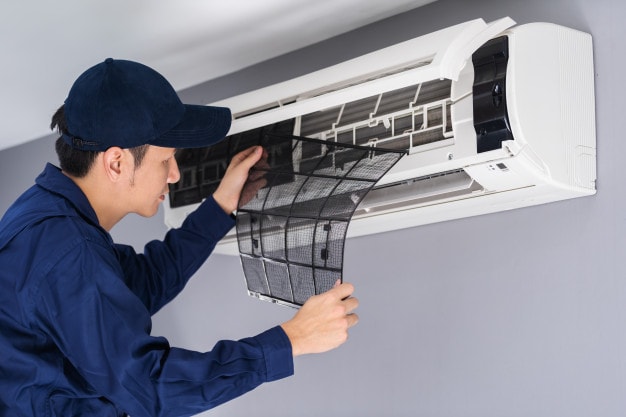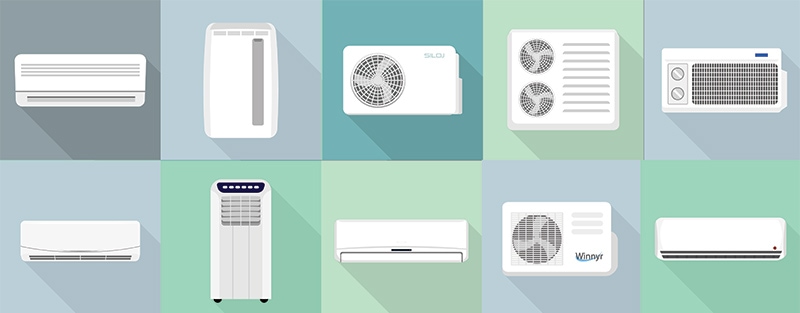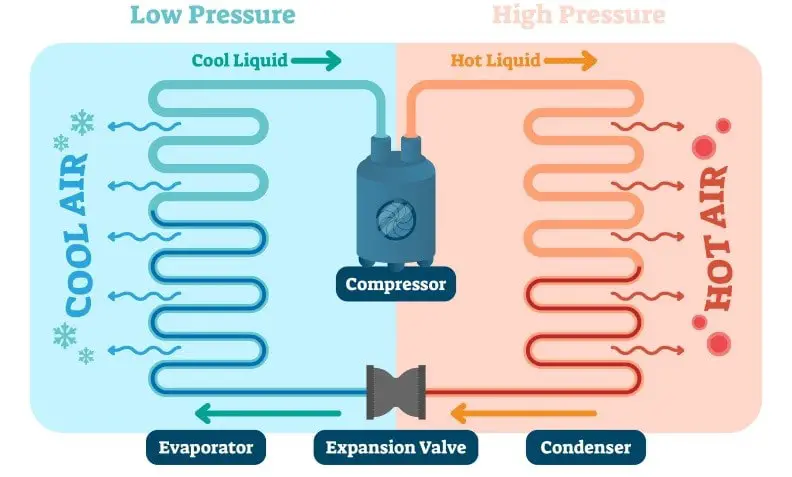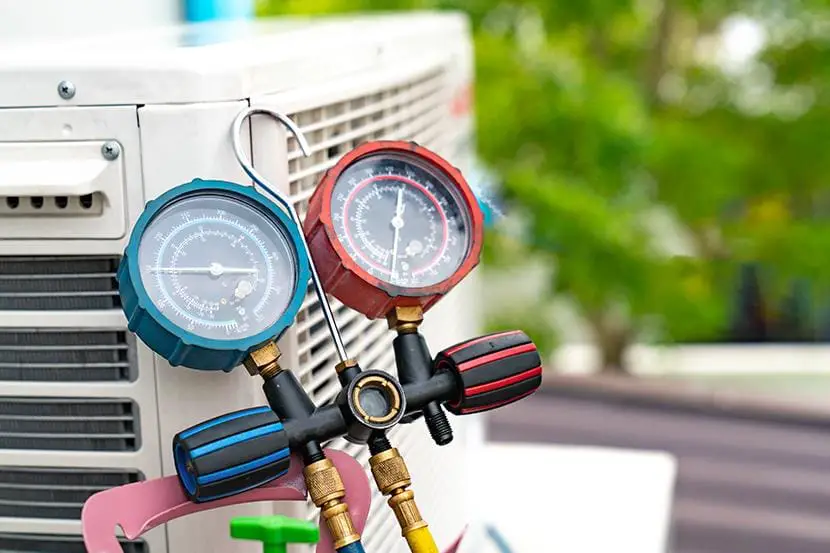Wondering how air conditioners function?
Air conditioners work by removing hot air from your home, transferring it outside, and cooling again. They use multiple internal components to provide your home with cool air, using a refrigeration cycle.
In this article, we have everything you need to know about how this works.

Air Conditioner Terminology and Common Concepts
Air conditioners are no different from any other technical equipment. Whether you are talking to a repairman or shopping for one yourself, there will be terminology and technical jargon that you may find yourself needing to know.
Despite each air conditioner being different, they all have the same basic principles. Hence, the technical terminology and component jargon are the same across all variations of this cooling unit.
Let’s have a look at these terms, so you know what they mean.
Refrigerant
A specific liquid that has the chemical properties to be able to become gas in exceptionally low temperatures.
Filter
Typically made of fiberglass or from pleated paper, it is a component that traps particulates and pollutants to ensure better air quality and to protect the unit itself.
Compressor
A component that puts the gas under very high pressure, which generates heat.
Evaporator Coils
The part of the unit that changes the refrigerant from a liquid into a gas.

Condenser Coils
This element turns the refrigerant from a gas back into a liquid, thus expelling this heat and cooling it once more for the next conditioning cycle.
Blower
These are fans that keep the air flowing throughout the whole system.
Ductwork
Channels or vents which dispense the cool air throughout the building/ area.
Aside from the inner-workings of an air conditioner, there is also terminology regarding the type of air conditioner you can have installed. This may differ depending on your building type, needs, and personal preferences. These terms are still good to know.
HVAC
Acronym meaning ‘heating, ventilation, and air conditioning’, refers to the industry of air conditioning.
Split System
One of the most common types of air conditioning systems used in homes, split into two units; one inside and one out. Easy to install as no ductwork is required.
Multi-split System

Multiple indoor units attached to one outdoor unit, can be used to condition more than one area of your home.
Ducted System
Includes an internal fan coil installed into the roof with a series of ducts installed throughout the home. Allows you to heat/cool multiple areas at once.
Hydronic System
Liquid-based system or heating and cooling, moves water through pipes under the floor.
How Does an Air Conditioner Work?
Air conditioning units pull warm air through return air vents in rooms throughout your home.
Coils inside the evaporator unit, filled with refrigerant then absorb the heat. This heat-packed refrigerant is then pumped outdoors to the condenser unit and this heat is released. Then the refrigerant travels back to the evaporator where the cycle starts again.
Step-by-Step Process
To better understand how this process works, we have provided a step-by-step guide that will explain exactly what is going on inside your air conditioner.
1. The evaporator coil meets warm air.
Warm air inside your home is drawn in through a vent. This warm air is then blown over the cold evaporator coil. This coil is located indoors and soaks up heat thus cooling the air.
2. The blower circulates the air.
The blower or fan then blows the cold air into air ducts, which then disperse this cooled air through your home. Refrigerant takes in heat from the circulating air and changes from liquid to gas.

3. The compressor decreases gas volume.
The compressor will decrease the volume of the gas, this often happens by ‘squeezing’ it through two solid objects. The temperature and pressure of the refrigerant are raised and it is ready for condensing.
4. The condenser releases the hot air.
By now the refrigerant is a hot vapor. It reaches the condenser, which is outside and is exposed to external air. This air takes heat from the refrigerant and lowers its temperature. This returns it into a liquid state.
5. The thermostat monitors temperature.
As the heat is dispersed outside, the cold refrigerant returns to the evaporator, and the process repeats. Once your home temperature is desired, the thermostat will then tell your AC to shut off.
Breaking It Down
You can liken the inner workings of an air conditioner to that of your refrigerator since both use a refrigeration cycle.

Any system that uses a refrigeration cycle will use chemicals known as refrigerants, although some do use water. Both your AC and your fridge will use these to absorb heat and compress the liquid into gas, before releasing it as hot air and creating a cooling effect.
A refrigerator uses a refrigeration cycle to move energy from one location to another to keep your food cool. Your AC is very similar as it moves internal heat from your home to an external location, carrying this heat in a refrigerant through the unit.
How Does Reverse Cycle Air Conditioning Work?
A reverse cycle air conditioner is more commonly known as a heat pump.
These air conditioners work by extracting heat from external air and transferring it inside your home. Like normal air conditioners, they use a refrigerant to warm the air that it brings inside.
A standard cycle air conditioner takes heat out of your home, places it outside, and supplies you with cool air. A reverse cycle air conditioner takes air from outside, heats it, and exudes it into your home, supplying you with warm air.
These units can often also filter and dehumidify the air, they are often more efficient than other types of electric heaters.

To Conclude
When you use one of these units you can either cool your air or heat it (with a reverse cycle). Refrigerant expands and condenses as it travels through the air conditioner, to provide your home with a comfortable temperature.
Air conditioning units are made from many components that work together to achieve this.
People Also Ask
We have answered your questions on how air conditioners work. However, there is always more to know about their workings. These are some of the most common questions people ask about air conditioners.
The short answer is no. They don’t. Though part of your system is located outside your home (in a split system). It does not take outside air and transfer it inside. It uses the outside unit to expel the unwanted heat.
A majority of air conditioners use a coolant/refrigerant rather than water, although some do. An air conditioner may leak water, however, though this is due to condensation as the air is cooled. It is not due to water content inside the unit itself.
Different air conditioners will have slightly different proceeds, but they all have the same general makeup. They will all use the same components and cycle to produce cool air, whether they are split systems or a small portable version.
Air conditioners up until recently primarily ran off of R22/Freon. However, due to environmental concerns R410A/ Puron, has replaced it. It has the same characteristics and is more efficient. Although, it can’t be used in systems that used to run off of R22.
